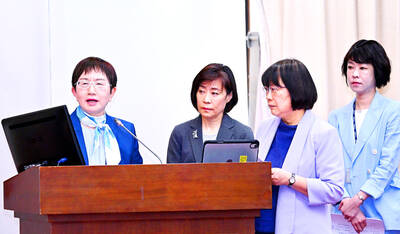Eyeing the strong market potential in downtown Taipei, hypermarket operator RT-Mart (大潤發) opens its 23rd outlet near Zhongxiao Fuxing MRT station today.
The 3,000-ping (9,900m2) store, located on the capital's Bade Road within a few minutes walk from the Breeze Center (微風廣場) and Sunrise Department Store (中興百貨), marks an important step for RT-Mart to develop its city-format outlet to exploit its target customers' strong purchasing power.
"With easy access to public transportation and our sufficient parking space, we're confident that this medium-sized outlet can rake in NT$2 billion (US$60 million) next year," Kaufmann Wei (
The hypermarket offers 600 car-parking spaces and 500 motorcycle spaces for its clients.
Establishing its first outlet in 1996 through the Taiwan-based Ruentex Group (
Asked how the operator deals with high rental costs in downtown area, Wei said they had to push up revenues to keep the rent ratio at between 3 percent and 4 percent of annual sales.
As office workers account for one-third of its target customers, the new outlet offers an exclusive range of stationery items. It has increased the percentage of fresh foodstuffs and cooked food, and decreased the amount of clothes, due to a high concentration of department stores and boutiques in the area.
To meet different market needs, it also provides services from home delivery of flowers and selling lunch boxes and gift boxes, to wireless services and free recharging services for mobile phone users.
"Based on our market survey involving 800 respondents, we've adjusted the product mix and increased some metropolitan services to satisfy our customers," said Kevin Kao (
Jennifer Wang (王琇姿), associate director at ACNielsen Taiwan's retail measurement services, said RT-Mart has obtained a good location to reach numerous customers but it must make sure its business strategies and service packaging can most benefit the majority of consumers.
Taking lunch boxes as an example, Wang said, as the food area is usually located in the back of hypermarket outlets to make room for kitchens, it is doubtful whether office workers would want to go into a spacious store for lunch.
"Perhaps it can develop a B2B (business to business) model to deliver lunch boxes to office buildings and so boost its revenues," she said.

‘SWASTICAR’: Tesla CEO Elon Musk’s close association with Donald Trump has prompted opponents to brand him a ‘Nazi’ and resulted in a dramatic drop in sales Demonstrators descended on Tesla Inc dealerships across the US, and in Europe and Canada on Saturday to protest company chief Elon Musk, who has amassed extraordinary power as a top adviser to US President Donald Trump. Waving signs with messages such as “Musk is stealing our money” and “Reclaim our country,” the protests largely took place peacefully following fiery episodes of vandalism on Tesla vehicles, dealerships and other facilities in recent weeks that US officials have denounced as terrorism. Hundreds rallied on Saturday outside the Tesla dealership in Manhattan. Some blasted Musk, the world’s richest man, while others demanded the shuttering of his

ADVERSARIES: The new list includes 11 entities in China and one in Taiwan, which is a local branch of Chinese cloud computing firm Inspur Group The US added dozens of entities to a trade blacklist on Tuesday, the US Department of Commerce said, in part to disrupt Beijing’s artificial intelligence (AI) and advanced computing capabilities. The action affects 80 entities from countries including China, the United Arab Emirates and Iran, with the commerce department citing their “activities contrary to US national security and foreign policy.” Those added to the “entity list” are restricted from obtaining US items and technologies without government authorization. “We will not allow adversaries to exploit American technology to bolster their own militaries and threaten American lives,” US Secretary of Commerce Howard Lutnick said. The entities

Minister of Finance Chuang Tsui-yun (莊翠雲) yesterday told lawmakers that she “would not speculate,” but a “response plan” has been prepared in case Taiwan is targeted by US President Donald Trump’s reciprocal tariffs, which are to be announced on Wednesday next week. The Trump administration, including US Secretary of the Treasury Scott Bessent, has said that much of the proposed reciprocal tariffs would focus on the 15 countries that have the highest trade surpluses with the US. Bessent has referred to those countries as the “dirty 15,” but has not named them. Last year, Taiwan’s US$73.9 billion trade surplus with the US

Prices of gasoline and diesel products at domestic gas stations are to fall NT$0.2 and NT$0.1 per liter respectively this week, even though international crude oil prices rose last week, CPC Corp, Taiwan (台灣中油) and Formosa Petrochemical Corp (台塑石化) said yesterday. International crude oil prices continued rising last week, as the US Energy Information Administration reported a larger-than-expected drop in US commercial crude oil inventories, CPC said in a statement. Based on the company’s floating oil price formula, the cost of crude oil rose 2.38 percent last week from a week earlier, it said. News that US President Donald Trump plans a “secondary